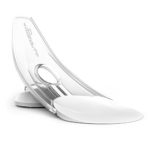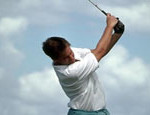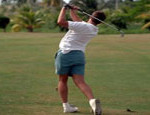PuttOut Pressure Putt Trainer – Perfect Your Golf PuttingThis training aid is designed to simulate the exact conditions of putting into a real hole on the green by it’s ground-breaking parabolic curved design


Power is a combination of two entities: Golf Swing Mechanics & The Body
Your golf swing mechanics is the efficiency at which you perform the golf swing. Essentially, the golf swing can be broken down into the stages. These stages are;
Each of these stages within the golf swing can be performed efficiently or inefficiently. PGA Tour players tend to perform the mechanics of the golf swing very efficiently, where as the 30 handicapper performs them very inefficiently. If the mechanics within each stage of the golf swing are efficient. The creation of power and transfer of this power into club head speed is at a greater percentage. On the flip side, if each stage is performed inefficiently. The amount of power developed and transferred into club head speed becomes a low percentage.
Efficient Golf Swing Mechanics = Greater Power Development and Club Head Speed
The first key in power development and the generation of club head speed is golf mechanics. Once we understand that efficient golf swing mechanics equals more power and club head speed. We can turn our attention to the “support structure” of your golf swing.
The body is what drives the golf swing. It is your skeleton, muscles, and nerves performing the mechanics of the golf swing. As a result, your body has a direct affect on how much power you generate in your golf swing.
The mechanics of golf swing requires certain levels of:
Optimal levels within these body categories allow for the possibility of performing the mechanics of the golf swing at their most efficient levels. For example, a full shoulder in the backswing is necessary for optimal power development. In order to perform a full shoulder turn, you must have a high level of flexibility. If you are lacking the flexibility to perform a shoulder turn it will affect the amount of power you can generate. Bottom line the body is the foundation on which the golf swing is developed. If you have a weak foundation, you will have a weak golf swing.
Just remember:
Efficient Golf Swing Mechanics + A Strong, Flexible, and Powerful Body = More Golf Swing Speed

A question for the ages in relation to the golf swing. Golfers around the world are familiar with the term club head speed. It is the rate at which the golf club is traveling at impact with the golf ball. Golfers are also familiar with the term power.
They know that power is directly related to club head speed. Knowing the connection between the two, which comes first? Read on to find out…
We understand that club head speed is the rate at which the club head is moving at impact with the golf ball. The development of club head speed is a result of your golf swing mechanics. It is essentially a summation of the entire process of the golf swing, beginning with address, moving through the backswing, into transition, onto the downswing, and completing with impact.
The paragraph above should answer the question of which comes first; club head speed or power? Club head speed is the result of power development with the mechanics of the golf swing.
Power development within your golf swing is contingent upon two entities. The first entity is your golf swing mechanics. Performing the mechanics of the golf swing efficiently elicits more power. Secondly, it is the body. Optimal power development requires certain levels of flexibility, balance, strength, endurance, and power within the body. Put these two entities together and you have the ability to generate high levels of club head speed within your golf swing.

Slicing the ball is a common problem among golfers. A slice is when the ball travels from one direction to the other [depending on the left or right-handedness of the golfer], generally not in the direction you want it to go. This contrariness of the ball not to go straight toward the hole is the bane of the golfing world.
Correcting a golf slice is not difficult, but may require plenty of practice, patience and more practice.
There are three ways to correct a slice. Hire a golf instructor, purchase some DIY books and/or grab a golfing buddy to follow you around the fairways and tell you what you’re doing wrong.
In the meantime, practice these simple guidelines in the backyard or out on the course.
Afterward, don’t forget to shout your golf buddy some liquid refreshment at the clubhouse. Important tips can be traded and your golf slice discussed with all the minutiae a relaxing cold drink allows.